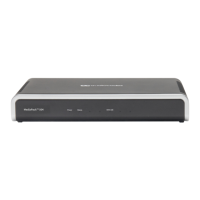Version 6.2 161 February 2011
SIP User's Manual 3. Web-Based Management
3.3.2.9 SAS
The SAS submenu allows you to configure the SAS application. This submenu includes the
Stand Alone Survivability item page (see ''Configuring Stand-Alone Survivability'' on page
161),
from which you can also access the 'IP2IP Routing Table' page for configuring SAS
routing rules (see ''Configuring IP2IP Routing Table (SAS)'' on page 163).
Notes:
• The SAS menu and its page items appear only if you have enabled the
SAS application (see ''Enabling Applications'' on page 102) and the SAS
application is included in the device's Software Upgrade Key (see
''Loading Software Upgrade Key'' on page 172).
• For a detailed explanation on SAS, see ''Stand-Alone Survivability (SAS)
Application'' on page 279.
3.3.2.9.1 Configuring Stand-Alone Survivability
The 'SAS Configuration' page allows you to configure the device's Stand-Alone
Survivability (SAS) feature. This feature is useful for providing a local backup through the
PSTN in Small or Medium Enterprises (SME) that are serviced by IP Centrex services. In
such environments, the enterprise's incoming and outgoing telephone calls (external and
internal) are controlled by the Proxy, which communicates with the enterprise through the
WAN interface. SAS ensures that incoming, outgoing, and internal calls service is
maintained in case of WAN or Proxy failure, using a PSTN (or an alternative VoIP) backup
connection and the device's internal call routing. To utilize the SAS feature, the VoIP CPEs
such as IP phones or residential gateways need to be defined so that their Proxy and
Registrar destination addresses and UDP port is the same as the device's SAS IP address
and SAS local SIP UDP port.

